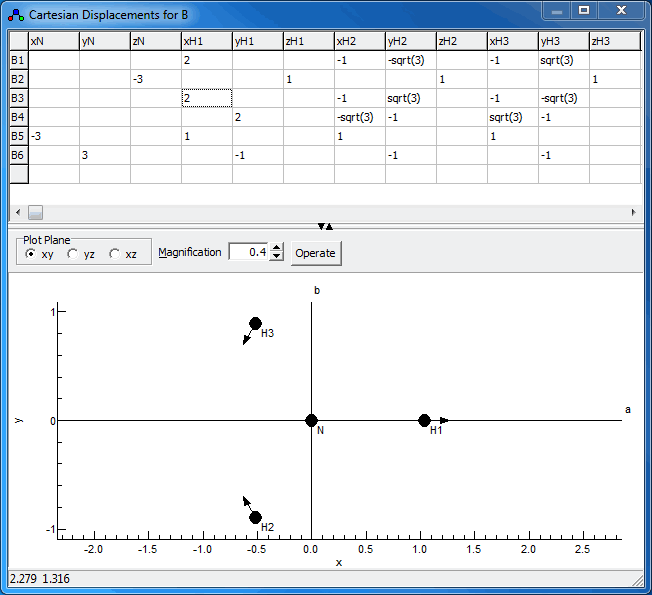|
|
<Prev Next> |
The Cartesian displacements object allows the display or input of the matrix, B, that transforms between the 3N Cartesian displacements, Δx and the 3N-6 (or more) internal coordinates, R:
R = B Δx
Redundant coordinates can be specified (i.e. more than 3N-6), though this imposes some constraints on the possible calculations. If the internal coordinates have already been specified as valence coordinates using an Internal Coordinates object, then the Cartesian displacements window can be used to display the valence coordinates in terms of Cartesian displacements. Alternatively the required internal coordinates can be directly specified in terms of Cartesian displacements by editing the values in this window. An example of this is shown below, for NH3 in a planar configuration. To create an internal coordinates object, right click on the Electronic State object object and select "Add New..., Cartesian Displacements". To bring up the window right click on the Cartesian displacements object and select "View...".

The plot at the bottom shows the current internal coordinate, i.e. the selected row in the top grid. The arrows indicate how far each atom moves. The plot updates semi-automatically; use "Operate, Check" to force an update.


| Check |
Check the contents of the top grid, and
update the plot to match |
| Remove R, T |
Force the coordinates to be orthogonal to
rotational and translational coordinates by subtracting the
projection onto these coordinates. The details of the
calculation are displayed in the Log
Window. |
| Calculate from l matrix | Set the B matrix by calculating it from the l
matrix assuming the internal Cartesian coordinates are the
same as the normal coordinates. The equation used is:B = lT M1/2 |

| Active | Set true to use this internal coordinates object; there
must be no more than one active internal coordinates object
at a time. |
| InPrincipalAxis | Specifies the axis system used in specifying the Cartesian
displacements; either the principal axis system or the axis
system used in the z matrix
specification. |
| Normalize | If true, the rows of the matrix given are
normalized before use in further calculations |